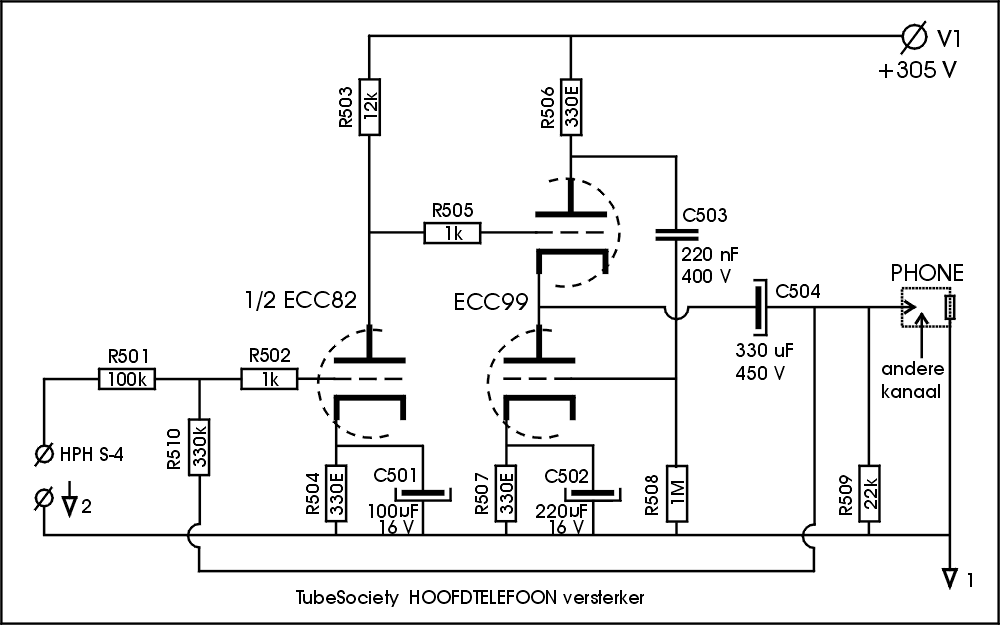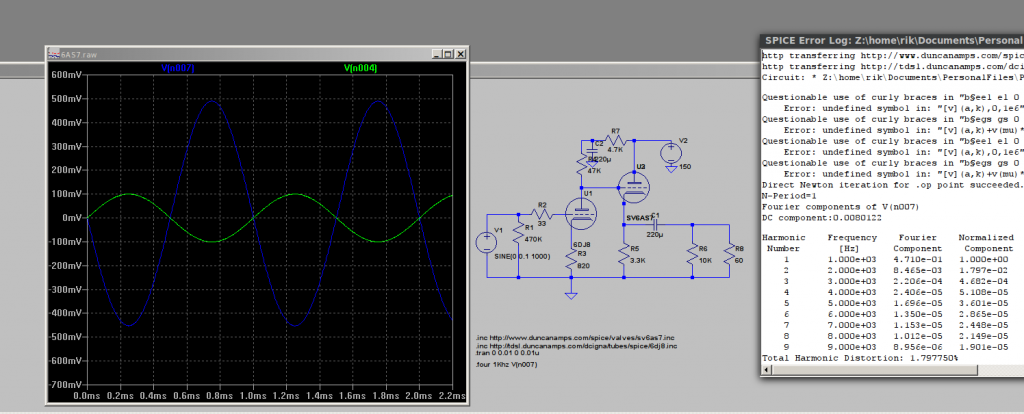As a hobby project I decided to build a tube headphone amplifier.
Why tubes you might ask, well, because they are awesome. Looking at efficiency, distortion etc transistors are vastly superior. But tubes are fairly simple to work with, look cool and it’s something different then all the opamp designs.
Requirements:
- Can drive 32 ohm headphones
- Some tube designs without an output transformer has issues driving low ohm headphones, as I also use normal 32 ohm headphones I need to have an amp that can drive them
- Can drive 250/600 ohm headphones
- As I also use a Beyerdynamic 990 pro with an 250 ohm impedance the amp also needs to be able to drive these headphones.
- Low(ish) distortion
- As it will be a tube headphone it’s impossible to get the ghastly low distortion figures that are possible with an opamp or transistor design. Still the distortion has to be low
- Low noise
- headphones tend to be extremely sensitive, 100db of sound with just 1mW of input power is nothing special. So the noise on the output has to be low, even 1mV of noise will be heard through some headphones.
- Low(ish) price
- It’s still a hobby project and I’m still a student. I can’t really spend hundreds of euros on an amplifier.
Circuit topology:
I want a fully tube design, not a hybrid design. Getting tubes to drive low low impedances like 32 ohm is not a problem with an output transformer. The downsides of output transformers is that multiple tabs are needed when you want to drive 32 and 250 ohm headphones, meaning they will have to be custom made. This means they will be expensive and hard to get.
An output less tube amplifier is quite common for headphones, designs using an 6AS7 or 6080 tube as cathode follower with half a tube per output are common. The downside is that the 6AS7 needs quite a bit of juice to get glowing, 2.5 amps to be precise. The other downside is the distortion. Simulated it went over to 1% at a 1Vpp output.
A better approach is using a so called “White cathode follower”. This is a topology that uses 2 tubes per output in a push pull configuration. This topology can deliver more current then an cathode follower and has a lower output impedance. It is a bit complexer and it requires two tubes per output but it has no problems driving an 32 ohm headphone. After a bit of searching online I found this schematic using an ECC99 tube per channel:

They claimed it can deliver 2V rms into an 32 ohm load. This is more then enough to generate over 120db of music. The other nice thing is that I had a few 6N6P tubes laying around. These cheap Russian tubes are very similar to the more expensive ECC99 tubes. I didn’t have an ECC82, only an ECC83, a tube with a much higher amplification factor.
Luckily this design uses some negative feedback to lower the output resistance, meaning the amplification factor is adjustable. After messing around a bit in LTSpice I came up with the following schematic:
It can deliver 45mA’s or about 3Vpp into an 32 ohm load or a massive 20Vpp into an 250 ohm headphone. 600 ohm headphones can expect a silly 42Vpp, which will fry most headphones with ease. Simulated distortion levels are low for a tube amp. About 0.3% @ 2Vpp in 32 ohm or 0.1% @ 10Vpp in 250 ohm. That looks good enough to try in real life.
The ECC99 design is designed by Menno van der Veen and found on his website which has a really nice tube preamplifier: http://www.mennovanderveen.nl/eng/ts-vv-2006.html




Greetings : )
I know this post is old, but did you ever finish building this amplifier? I’ve got a few 6N6 tubes lying around and this looks like a great use for them.
I did yeah :)
It works pretty great for a long while now, so should be fine to rebuild :)
hi,
Just found your interesting blog, googling for headphone amp with vacuum valve. Just a little problem, the first schematic seems gone somewhere else from this post :/
thanks !
oups, just found it on the new version of the TubeSociety web site : https://www.mennovanderveen.nl/images/onderzoek-ontwikkeling/projecten_tubesociety/project2006/groot/FIG-7_TS-HPH.gif ;)
Hi. That’s indeed it. Thanks for the feedback, should now be fixed :)